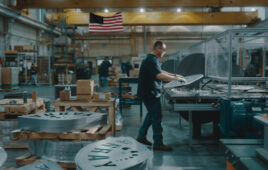This installation tip was provided by Johan Alfsen, senior director of product marketing, Everest Solar Systems
Residential solar installers can reduce labor and material costs by using shared-rail systems. Racking prices have come down in the last five years, and a focus has been on rail-free systems to reduce costs further. But these systems have yet to deliver the savings installers hoped for and instead created a steep learning curve. However, shared-rail systems have reemerged to provide a happy medium by using traditional rails while reducing materials.

A visualization of shared rail solar mounting systems. Everest Solar
Shared-rail systems have been around since residential solar gained popularity. Shared-rail and rail-less systems attach to roofs similarly, but the former requires less precision. With shared-rail, installers have a rail as a foothold on steeper roofs and another to manage wires.
Shared-rail systems can be trickier to install. They have limited grounding options and work only on certain roof types and layouts.
Racking manufacturers have started using standard racking systems to also work in a shared-rail layout, with minimal differences in hardware.
Since many roofs are rectangular in shape, a landscape orientation can fit more panels. However, designing an array in landscape can sometimes double the material cost of racking — not to mention labor. Installers will avoid landscape orientation, despite customer preference and increased power density.
Three concerns that Everest Solar Systems hears from homeowners is cost, risk and aesthetics. Shared-rail options directly impact all three of these concerns. By reducing materials and labor, shared-rail systems can make solar proposals more competitive and attractive. With fewer penetrations in a roof there is a reduced chance of leaks. With fewer materials on the roof and hidden rails in the shared system, aesthetics improve and installers can use standard mill aluminum instead of higher priced dark black rails. All these factors make shared-rail an easy system to reduce labor and material costs on the roof.




Tell Us What You Think!